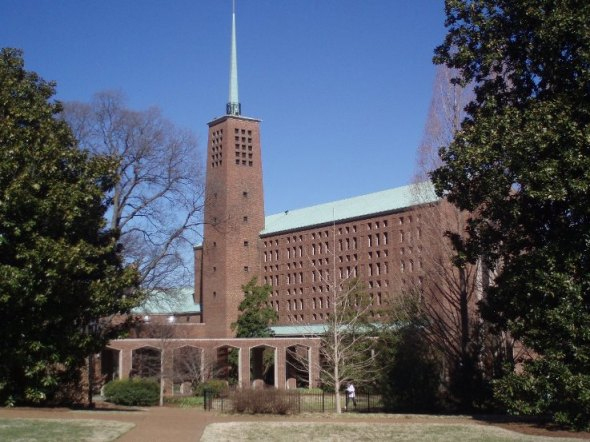Benton Chapel
Benton Chapel is the largest and main chapel for Vanderbilt University. Dedicated in 1959, the chapel would become the ecumenical home for various ministries, classes, promotions and special events in the lives of the students, staff, faculty and community here at Vanderbilt. Although decorated in a Christian theme, no one denomination is prevalent making the chapel available to be used by different denominations and traditions throughout the week.
The address is 411 21st Ave South, Nashville, TN 37240
Read this excerpt from the Vanderbilt Divinity School’s publication The Spire from the summer of 2009 written by Bonnie Cooper Chappell.
An entire semester at the Divinity School passed before I found myself in Benton Chapel.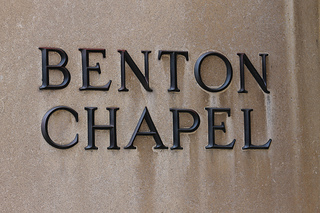 On a radiant spring afternoon, I instinctively veered left as i walked toward 21st avenue, South instead of taking the familiar right turn to the library. After climbing the stone steps to the entrance, I pulled hesitantly on the knight handle guarding the door, not wanting to disrupt whatever might be going on inside.Entering the foyer and finding the building empty, I drank in the calming silence and immediately decided that the chapel was the perfect place to work on my essay on Emily Dickinson’s exploration of spiritual formation and the Crucifixion in “The Props Assist the House.”
On a radiant spring afternoon, I instinctively veered left as i walked toward 21st avenue, South instead of taking the familiar right turn to the library. After climbing the stone steps to the entrance, I pulled hesitantly on the knight handle guarding the door, not wanting to disrupt whatever might be going on inside.Entering the foyer and finding the building empty, I drank in the calming silence and immediately decided that the chapel was the perfect place to work on my essay on Emily Dickinson’s exploration of spiritual formation and the Crucifixion in “The Props Assist the House.”
I walked past the statues of Dismas and Lazarus, made my way up the green terrazzo stairway, and sat down in a pew in the middle of the balcony. I stayed in that pew for several hours, allowing my gaze to alternate between my volume of Dickinson and the soaring ceiling, between the notepad in my lap and the afternoon light streaming through the stained glass. Benton Chapel filled me with theological insight, centering both my essay and my spirit.
Benton Chapel celebrates its fiftieth anniversary this year. Since 1959, the chapel’s spire has stretched into the Nashville skyline, reminding the Vanderbilt community of a most basic commitment: the place of the sacred in intellectual pursuits.
The chapel has served the Divinity School as its symbolic scaffolding, offering support in times of growth and struggle, and as its foundation, helping students and faculty alike to keep central the faith that drives their studies and vocational discernments. In the fifty years since the construction of Benton Chapel, Vanderbilt Divinity School has matured into a leader in theological education and a committed advocate of social justice; it now stands “adequate, erect.” We mark the anniversary of Benton Chapel— proud that such a fine structure stands on our campus and proud of the history that makes its presence central to the work of the Divinity School.
in the mid-1950s, Divinity School Dean John K. Benton set in motion plans to move the School to a new building all its own. Wesley hall, the School’s original home, was destroyed in a fire in 1932. after a few years in leftover space in Kissam hall and Neely auditorium, an old YMCA facility was added to Vanderbilt in 1936 and christened the new Wesley hall. Twenty years later, the time had come to provide the Divinity School with a more appropriate space. early plans provided for “administrative and faculty offices, classrooms and refectory, men’s dormitory and chapel,”that eventually became the Divinity Quadrangle. Dean Benton died on august 21, 1956, three years before the building was completed. Benton Chapel is dedicated to his memory, and the space continues to celebrate the legacy of this important figure in Vanderbilt history.
Benton came to Vanderbilt in 1939, inheriting a School of religion steeped in financial crisis. During his tenure as dean, financial difficulties were eased as the School rose to national prominence. Under Benton’s guidance, the School of religion increased its focus on ministry, improved the library facilities and increased its circulation, and attracted a number of prominent faculty members. Dean Benton also was involved in the 1952 decision to admit African American students to the Divinity School. In 1956, the School of religion became Vanderbilt Divinity School, signaling the School’s membership among the most prestigious theological schools. at the time of Benton’s death, the School was “a major, interdenominational institution that would soon rival the best in the country.” The naming of Benton Chapel is a most appropriate tribute to a man who contributed significantly to the Divinity School.
After Benton’s death, J. Philip Hyatt, professor of Old Testament, served as interim dean, and discussions of a new home for the Divinity School continued. During this interim period, Marvin Halverson, executive director of the National Council of Churches’ Department of Worship and the Arts, visited Vanderbilt as a consultant for the University’s plans for a new chapel. Halverson praised the Divinity School for taking such a step, asserting that the project had “a singular possibility of making a fresh architectural statement for theological education.”
J. Robert Nelson became the dean of the Divinity School shortly thereafter, and he oversaw the building project through its completion, including “a lofty chapel in contemporary style.” The Nashville architectural firm of Brush, Hutchison & Gwinn was hired to design and construct the new building. In his consultations with the building committee, Halverson noted the importance of architects being prepared to explore “the symbolic role of the religious building in the community.” Brush, Hutchison & Gwinn proved more than willing to enter such exploration; in the midst of a secular university, they created a structure that attests to the importance of worship.
The space continues to celebrate the legacy of this important figure in Vanderbilt history.
While the firm of architects oversaw the structural considerations of the chapel’s construction, a number of artists were brought in to attend to the aesthetic elements of the building. Most notably, Robert Harmon of Emil Frei, Inc., in St Louis, Missouri, was commissioned to design the chapel’s stained glass windows. The plans included the more than three hundred small windows that flood the space with colored light and one elaborate window above the entry doors, the Word of God window. The building committee determined the Word of God to be an appropriate theme for the window, suggesting that it “is basic for the essential concern of theological education—the wholeness of the Christian Gospel” and that “it lends itself to artistic expression.”
Within the window itself, this theme is represented through the waters of chaos and the inspiration of creation, as the seed that carries the logos into the world, and as Christ, the Word incarnate. This beautiful window, the funds for which were given by Divinity School alumni/ae in memory of Dean Benton and in honor of the School’s continued work, serves as a continual reminder of the space Vanderbilt makes available for the study of religion. A great deal of energy went into securing quality stained glass at an affordable price. The figure $20 per square foot is mentioned repeatedly in correspondence between Dean Nelson and Robert Harmon. Though the artist urged the Dean to allot more of the budget to the chapel’s windows, all parties involved felt that the glass used in the end was most reasonably priced. In one letter, Dean Nelson jokingly remarked that compared with the $160 per square foot glass that was used in constructing a window at The Upper room, the chapel’s stained glass seemed like “bargain basement stuff.” 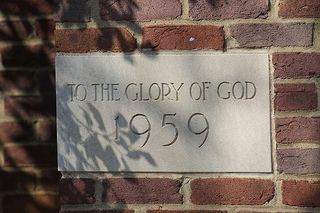
Several other artistic details complete the space. on the building’s exterior, the cornerstone proclaims simply, “To the glory of God,” and wrought iron iconography surrounds the walls. Two pairs of metal knights, each holding swords, serve as door handles at the main entrance. A pair of statues representing in poignant detail the biblical figures Dismas and Lazarus stand in the foyer and are dedicated to Edwin Mims, professor of english literature from 1912 to 1942.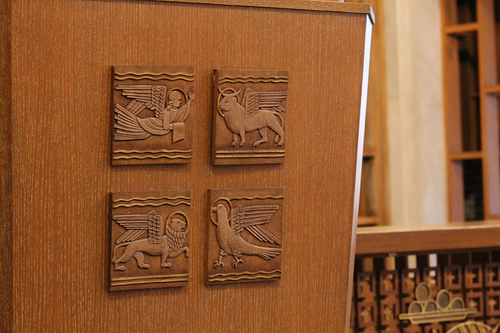 On the pulpit are four carved panels, each representing an evangelist, helping speakers to proclaim the good news. Dean Nelson once admitted, “I have discovered quite by accident that one of the most attractive architectural features of the building is the rounded stairway coming from the ground floor to the chapel.”
On the pulpit are four carved panels, each representing an evangelist, helping speakers to proclaim the good news. Dean Nelson once admitted, “I have discovered quite by accident that one of the most attractive architectural features of the building is the rounded stairway coming from the ground floor to the chapel.”
Basic considerations for the requirements of a chapel included the installation of a public address system. Though this seems an obvious choice for such a large space, the sound system was almost omitted. While the architects made provisions for the system’s incorporation, Dean Nelson reported that the faculty felt it an unnecessary addition: “Sleeth is of the strong opinion that we do not need any such thing at all. as professor of preaching, he insists that any half way respectable preacher will have the voice adequate to fill that Chapel. As to the acoustics, he said that is what we have architects for!” Robert Gwinn responded that though he and the other architects “sincerely trust you will develop strong-lunged preachers who will be able to fill the Chapel without mechanical aid…. The PA system is, we feel, a precautionary measure costing a minimum amount of money.” Having attended lectures of soft-spoken professors in the chapel, I am certainly grateful that the architects’ pragmatic proposal was accepted.
Dedication ceremonies for the Divinity Quadrangle and Benton Chapel were held on March 20–22, 1960. General opinion of the building around the University was unanimously positive. Dean Nelson beamed that visitors “expressed their appreciation for the design and construction of the building in the most extravagant terms.” Sidney F. Boutwell, Assistant Dean of Men, commented that the Divinity Quadrangle was “a very handsome addition to the campus.”i in the historical context of the University and the Divinity School, the completion of this major building project was eclipsed by a series of events as foundational for the University as the brick and mortar that support Benton Chapel.  As Benton Chapel and the Divinity Quadrangle changed the physical landscape of the University, the Divinity School took on an increased role in Vanderbilt’s ideological landscape. in the fall of 1959, Divinity student James Lawson began leading training sessions in non-violent resistance in preparation for a lunch counter sit-in campaign aimed at integrating downtown Nashville. Lawson moved to Nashville in conjunction with his work for the Fellowship of Reconciliation, hoping to play a role in the developing Civil rights Movement. Because the Divinity School had been admitting African American students since 1952, Lawson was able to work toward his baccalaureate while maintaining an active role in the Nashville community.
As Benton Chapel and the Divinity Quadrangle changed the physical landscape of the University, the Divinity School took on an increased role in Vanderbilt’s ideological landscape. in the fall of 1959, Divinity student James Lawson began leading training sessions in non-violent resistance in preparation for a lunch counter sit-in campaign aimed at integrating downtown Nashville. Lawson moved to Nashville in conjunction with his work for the Fellowship of Reconciliation, hoping to play a role in the developing Civil rights Movement. Because the Divinity School had been admitting African American students since 1952, Lawson was able to work toward his baccalaureate while maintaining an active role in the Nashville community.
In February of 1960, the sit-in campaign and the protests it generated gained so much attention both in Nashville and beyond that the University became uncomfortable with Lawson’s prominent role. On March 2, Lawson was given twenty-four hours to withdraw from the University or face expulsion; Chancellor Harvie Branscomb announced on March 3 that Lawson was no longer a Vanderbilt student. The Divinity faculty was shocked and dismayed by the administration’s actions, and they worked diligently for Lawson’s readmission. When attempts to have Lawson simply apply again were rejected by the University, nearly every faculty member submitted letters of resignation. The administration was so frustrated with the ordeal that it threatened to turn the newly constructed quadrangle, Benton Chapel and all, over to the Law School. Dean Nelson even sent a letter to Brush, Hutchison & Gwinn in which he conveyed his remorse that their creation would “not be used indefinitely for its intended purpose. I hope that you understand the inevitability of the decision which we of the faculty have taken,” Nelson told the architects. “it is with the utmost regret, not only because of this building and the University but because of friends like you and the community of Nashville which we love.”
The Lawson affair was so much a part of Vanderbilt’s life at the time that it was the topic of the chapel’s dedication address on March 21, 1960. Liston Pope of Yale Divinity School delivered a speech on that occasion in which he chastised the University for its opposition to Lawson’s activities and praised the Divinity School for its uncompromised support of Lawson. In the months following the building’s dedication, the faculty continued to work for Lawson’s reinstatement. Not until a number of professors from the Medical School and from the College of Arts and Science threatened to resign were the concerns of the Divinity School adequately addressed. That summer, on June 13, James Lawson was readmitted to Vanderbilt, though he chose not to return. With their demands recognized by the administration, the Divinity faculty withdrew their resignations. The events of 1960 forced Vanderbilt to grow and change in ways other Southern universities had not yet done, and they secured for the Divinity School a prophetic role within the University.
Harvie Branscomb’s involvement in the chapel runs deeper than his general approval of the project. The chapel project as a whole, including the creation of a Chaplain position within the University, was part of Branscomb’s plan for Vanderbilt from the beginning. Before his tenure as Chancellor, Branscomb served as the dean of Duke Divinity School and was a prominent New Testament scholar; the establishment of a first-rate divinity school at Vanderbilt was important to him. Branscomb oversaw the creation of the Office of University Ministry, feeling “that preaching in a nondenominational context would really bring quality thought to religious issues and engage the Vanderbilt community in discussion of these important matters.” Chancellor Branscomb’s commitment to the availability of ecumenical preaching on Vanderbilt’s campus, and to the University’s continued support of theological studies, was so great that he is now part of Benton Chapel’s physical structure. his ashes, along with those of his wife Margaret, are interred in the wall just to the left of the pulpit.
On the Vanderbilt campus today, Benton Chapel continues to stand tall, reminding visitors of the importance of making a place for the study of religion and for inclusive worship in an academic institution. 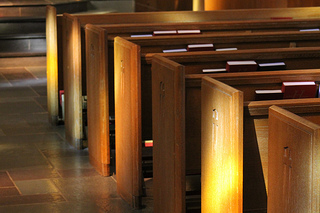 Today the chapel is the setting for several lectures, including the Cole Lectures, which take place every year during homecoming and reunion weekend, and the Antoinette Brown Lecture, which highlights the work of women in theological scholarship. Worship services of multiple denominations also take place in the space each week. Benton Chapel remains unlocked, allowing students, faculty, and visitors to enter the sanctuary for prayer and meditation, or for the composition of essays. in the midst of a bustling college campus, the chapel offers peaceful silence.
Today the chapel is the setting for several lectures, including the Cole Lectures, which take place every year during homecoming and reunion weekend, and the Antoinette Brown Lecture, which highlights the work of women in theological scholarship. Worship services of multiple denominations also take place in the space each week. Benton Chapel remains unlocked, allowing students, faculty, and visitors to enter the sanctuary for prayer and meditation, or for the composition of essays. in the midst of a bustling college campus, the chapel offers peaceful silence.
Since its spire first reached fifty years ago into the Nashville sky, Benton Chapel has been fully incorporated into the life of the Divinity School and the University, providing a place where ecumenical worship and academic theological exploration are allowed to complement each other. Perhaps a part of the inspiration for my essay on Dickinson’s poem came from the voices of great theologians that continue to echo through the chapel: Rudolf Bultmann, H. Richard Niebuhr, Paul Tillich, Paul Ricoeur, Walter Brueggemann, Gustavo Gutiérrez, James h. Cone, Sallie McFague, Phyllis Trible, Elisabeth Schüssler Fiorenza, Peter Gomes, Ada-María Isasi Díaz, and Katie Canon. They have breathed the forces of their lives’ work into our chapel, and as beneficiaries of their service to the academy, we are surrounded and uplifted by the weight of their work. The contributions of such scholars and the intellectual gifts from generations of professors and student theologians comprise an unrepeatable legacy to our Divinity School; they have “affirmed it a Soul.”
Bonnie Cooper Chappell earned her baccalaureate, summa cum laude, in English and Christianity from Mercer University. She graduated from Vanderbilt University Divinity School with the master of theological studies degree in December 2009.

